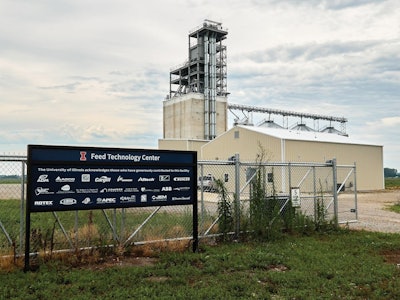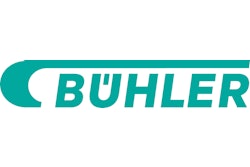
Because none of the feed produced at the FTC is made for commercial use, the facility is not subject to Feed Safety Modernization Act (FSMA) regulations and Food and Drug Administration (FDA) inspections, and it can take some risks with ingredients as part of research that commercial feed mills cannot.
“Even though we are not subject to FDA inspections, we are trying our best to follow FSMA guidelines and requirements, by having defined standard operating procedures and following current good manufacturing practices. For example, in this facility, we evaluate several novel ingredients that commercial facilities might hesitate to onboard — the whole purpose of taking that risk is using that and understanding what might be some of the safety and quality issues related to these novel ingredients. This is what we do in research,” Godoy says. “And so, we are aware that maybe this is a higher-risk facility, but for that same reason, we don’t want to commercialize anything. We’re controlling that kind of risk. Our goal is to generate data to continue to build our knowledge in nutritional and feed sciences and support the animal food industry to produce nutritionally adequate and safe products.”
The research setting also allows for discovery about processing and equipment, Peters adds. “Not only can we do research diets to evaluate nutritional properties, but we can do research investigating processing parameters. We can look at batch times, we can look at moisture content, being a modular facility, we can add different pieces of equipment … we can try different things out, new products, that other mills and pro- duction facilities wouldn’t be able to do because of downtime and costs and things. We can try it and work with those groups,” he says.
When the University of Illinois moved feed production from its nearly 100-year-old feed mill to the new Feed Technology Center (FTC), it was like going from a horse to flying in a spaceship, says Maria Regina Cattai de Godoy, associate professor and Feed Technology Center fellow.
“Besides safety and a lot of issues that we had with being a 100-year-old facility, it also was not relevant to teach there because it was all manual and not reflective of current practices of the animal food industry,” she says.
The $20 million, 12,000-square-foot facility in Urbana, IL, which became operational in March 2021, produces research diets for the university, provides hands-on learning for students, and supports industry outreach and education. It replaces the previous 95-year-old feed mill and uses all new equipment and software, donated by major players in the industry, including Bühler Inc., JEM International, Wenger Mfg. and Cablevey Conveyors. Several partners also contributed financially to the FTC.
The FTC features 195,000 bushels of whole dry grain storage, including three 65,000-bushel grain bins; a 10,000-bushel wet grain bin; 14 overhead bulk storage bins and several 2-ton bins for minors, micros and warehouse storage; a dryer capable of drying up to 1,000 bushels per hour; a completely automated control system; and a standalone extrusion line. The mill employs three full-time staff.
Plans for the FTC have existed for more than 20 years, but the funding had not been available. In September 2018, the university entered into a public-private partnership, similar to a lease-to-own arrangement, that enabled the project to proceed quickly. Construction began in June 2019.
“We had the perfect opportunity to create a plan for internal funding, and work with the private sector to get this rolling, which otherwise I think would have even taken longer to do it,” Godoy says. “And this ability now to work with the private sector that before didn’t exist, is really what allowed us to be where we are today.”
Feed mill supports research, teaching and outreach
Godoy says the goal of the FTC is to support the three main pillars of a land grant university: research, teaching and outreach.
“One of the primary goals that we have is to expand its use on the research front. For the first year, that can be challenging because FTC employees are learning operational ranges, and what might be some of the limitations, and how to go around some of those things that may not work perfectly. But now I think we’re getting to the position that we can take larger research projects, because they’re much more comfortable with all the ins and outs,” she says.
The FTC supports the university’s teaching mission in several ways.
“There’s current courses that were already developed, but they didn’t have a hands-on capability. So now we have courses like mine, where I teach about feed manufacturing, that I can bring them here,” says Godoy, who teaches in the Department of Animal Sciences & Division of Nutritional Sciences in the College of Agricultural, Consumer and Environmental Sciences. “Before, I would have to find somewhere else to take them or just show photos and images. They can come here and see and put their hands on, and I think that makes them much more excited about it.”
Because students now have access to the feed mill, unlike in the past, interest has grown and more stu- dents can have hands-on experience at the mill when working on their research projects.
“When Bühler was here, when we were commis- sioning our pellet mill, we hosted a small short course on what pelleting is, the process and what all goes into it, and I think we had a pretty good turnout,” says Leon Peters, FTC facility manager. “We had probably 15 or 20 students that came just for that — just to learn about pelleting. So, there’s a lot of opportunities that can be explored with our industry partners that we’re really kind of excited about and looking forward to — little things that are maybe outside the classroom experience, for those students that are interested in learning more about these technologies and field.”
Bühler contributed more than $1 million in milling, grinding, mixing and pelleting equipment, and is developing a multichannel, inline NIR system, which will monitor the compositional quality of feed ingredients, in real time, during diet preparation.
“They cannot sell that technology without it being fully developed,” Godoy says. “So it does help us long term because we really want to do research and learn how to create this precision formulation. But it also helps them because it gives them a venue to come and test in a much more low-stakes environment than it otherwise would be.”
Godoy added that the FTC provides many opportunities to support current courses at the university or develop new curriculum. “We are working toward developing a minor in feed science and other work- shops and short courses that may not only serve our traditional students, but also our nontraditional, non- degree-seeking students,” she says. “We also have a nonthesis master’s program on campus and online, and several certificate programs that also can leverage the FTC’s capabilities.”
Learning by being able to take risks
The FTC produces 3,000 tons of mash, pellet and extruded feed per year and has the capacity to produce 9,000 tons annually. Diets for use on the university’s poultry, beef, dairy, swine, sheep and horse farms make up 70% to 75% of the mill’s production. The remainder is research diets, with all of the feed produced at FTC for university use only.


















